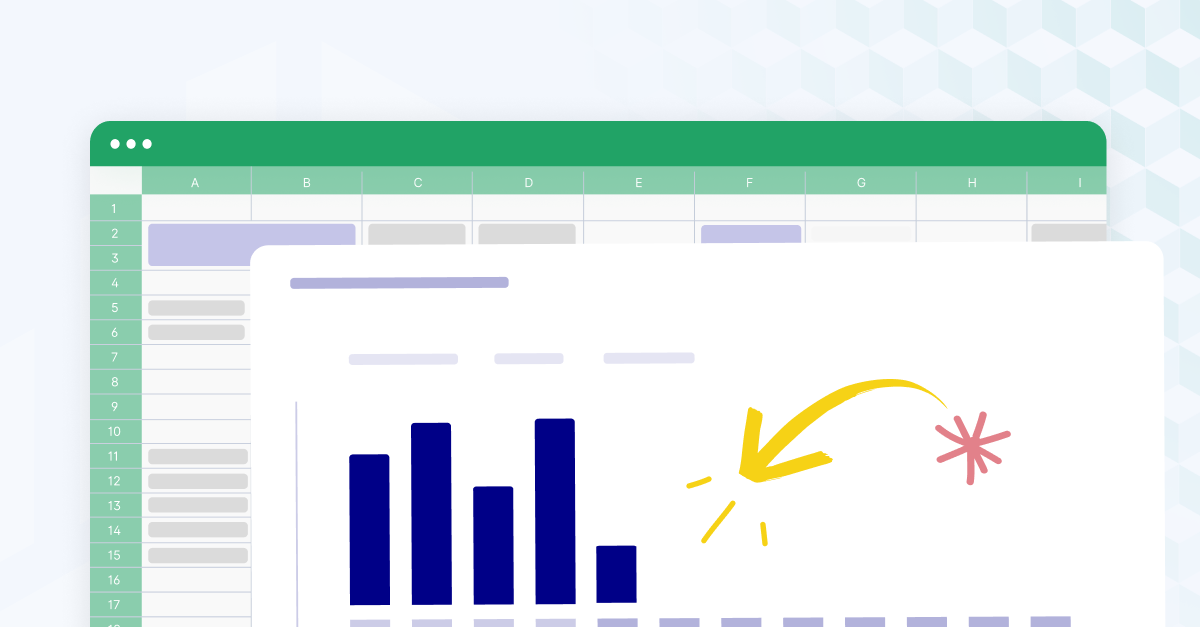5 budgeting best practices for busy FP&A teams
There's a lot of advice out there about creating a budget.
That's why we've summed up our 5 best budgeting best practices for you.
1. Build every budget around the long-term plan
Budgeting for the long term ensures that resources go to the highest good.
For instance, while cost-cutting measures may benefit the immediate numbers, the budget must also support effective growth.
Cutting too deep risks under-resourcing key departments, which may have a positive short-term impact but ultimately be unsustainable.
Budgeting through a downturn should still provide funds to keep the company profitable and growth-minded.
2. Create achievable goals for the business
Everyone loves a stretch goal, but analyzing your goals against your current sales numbers, revenue expectations, and cash resources helps you know if your goals are too ambitious to be reasonable.
Setting slow, steady goals with reasonable increases will produce better results over time than setting the bar too high and missing.
3. Build scenario planning into your budget process
Scenario planning and what-if analysis provide the insight needed to anticipate potential future events and their associated impacts on the budget.
When you consider multiple scenarios, you can better prioritize investments and prepare for any changes in market conditions or customer requirements.
Scenario-building makes budgets resilient to external changes, allowing for more agility in a downturn.
4. Consider a rolling budget approach
A rolling budget is a strong tool when you need flexibility in planning. Rolling budgets give teams the power to be more agile and adapt to market changes or customer demand.
It empowers strong performance reviews against goals and informs changes in spending and allocation.
If your annual budget process can’t keep up with change, a new budget process might be a better solution.
Build a savings-minded budget
Creating a savings-minded budget is key to financial stability. It ensures you can plan for future investments, debt reduction, and retirement to weather unexpected financial storms.
Prioritize by setting aside emergency funds and separate accounts for each goal. This builds financial security and resilience for long-term success.
5. Choose the right budgeting method
Every business has a different structure with different financial planning needs. Consider taking a different approach if budget planning is strenuous or the results aren't there.
Incremental budgeting is a great approach for quick changes and strategy shifts that don't require extensive financial data. An incremental budget will provide the flexibility to make adjustments quickly while also providing insight into how spending decisions influence performance.
Zero-based budgeting is another popular method with its own advantages. With zero-based budgeting, you start from scratch each year, analyzing each line item of the budget and ensuring that every dollar spent is justified. This method can provide greater control over expenses and help you to focus on strategic priorities.
Dynamic budgeting is an iterative approach that allows for adjustments in spending as performance indicators change. It's a great option for businesses with rapidly changing market conditions or unpredictable sales cycles.
Activity-based budgeting is a method that looks at the cost-benefit of activities and programs. It's ideal for businesses looking to identify areas where they can enhance efficiency or increase profitability.
Value Proposition budgeting is an approach that considers the customer value created by each activity or program. It's great for companies looking to maximize the impact of their investments and increase customer satisfaction.
Regardless of your chosen budgeting method, it's important to understand key performance indicators (KPIs) to align spending with your business goals.
Biggest challenges with the annual budget process
The annual budgeting process can be stressful for the finance department (which is why we’ve never met anyone who says, “It’s budgeting season” with a ton of enthusiasm.)
Plenty of challenges can make budgeting difficult, but it can get easier with the right strategies and processes.
Here are the top 5 challenges to consider when building annual budgets:
1. Unforeseen expenses
Unexpected costs, such as emergency repairs or extra materials, can quickly deplete available funds.
While it’s possible to predict some costs well in advance, changes in the markets, commodities costs, or unexpected equipment failures can quickly sap contingency funds.
Putting aside enough for a rainy day is key to weathering changes in spending.
2. Varying revenue sources
If income comes from multiple sources with fluctuating amounts, it can be difficult to accurately project the total amount.
This is especially true for businesses that derive income from investments and dividends rather than straight sales revenue.
3. Inaccurate forecasting
Budgeting mistakes can occur when forecasting expenses and revenues if historical data is not studied carefully or if market trends are not considered.
While forecasting can’t capture every possibility, a strong scenario planning process can give you options when things change.
4. Limited resources
When budgets are tight, managing resources efficiently to stay within the allocated funds can be difficult.
Budget overruns have a compounding effect on the business, making it difficult to plan for the future while promoting healthy growth in the present.
Conducting cost analysis on a regular basis may improve your spending efficiency and make your budget dollars go further.
5. Seasonality
Budgeting can be challenging if your revenue isn’t even through the year. The highs and lows can cause businesses to overspend or underspend their budgets.
Even when accurate forecasting is utilized, predicting how much money will come in and be allotted for expenses can be difficult.
Building complementary lines of business or balancing seasonal income with investment revenue sources may help regulate cash flow.

Selecting the right budgeting method for your business
Before we talk about the four major budget methodologies, it’s helpful to understand that each comes from two different high-level approaches: bottom-up and top-down budgeting.
Let’s take a look at each to understand the rationale behind them and understand how they might serve your business:
Bottom-up budgeting
Bottom-up budgeting starts by estimating the costs of individual components or projects and then aggregates these to summarize objectives, goals, and overall strategy.
It’s based on budget assumptions that state every decision-maker has an understanding of their role and that they know how their decisions relate to the larger organization.
Bottom-up budgeting enables organizations to consider external factors such as emerging trends, customer demands, and competitive pressures in their budget planning. It also enables more accurate forecasting.
The bottom-up budget is often reviewed on an ongoing basis to ensure the accuracy and appropriateness of estimates.
Top-down budgeting
Top-down budgeting comes from the executive level of the organization.
In this model, the overall financial strategy and objectives are determined first, then passed down to individual departments or teams.
The rationale in top-down budgeting is that decisions made at the top are most appropriate for all levels of the organization. These high-level decisions then inform individual actions.
The top-down budget is better for organizations with a clear structure between decision-makers.
The downside is that it can be time-consuming and difficult to maintain if the organizational structure changes often since it requires frequent adjustments at each level.
Static vs. dynamic budgeting
The other major difference in approach when budgeting is whether to make a plan once and stick with it or look at the numbers at intervals and adjust as new information comes in.
This is called static budgeting (annual or traditional budgets) versus dynamic (or rolling) budgets.
Static budgeting means creating a financial plan that does not change over time, even if the environment or circumstances do. It's based on the idea that the organizational structure will remain constant. It’s designed to provide predictability and stability for budgeting purposes. The idea is to set a budget once, then stay within it over the course of the period.
Static budgets are useful in organizations with long-term goals and consistent processes, where decision-makers are confident about their ability to accurately forecast needs and measure performance against budget expectations.
Rolling budgets provide an organization with greater flexibility and adaptability than static budgeting.
It’s regularly adjusted to reflect changes in estimates, resources, objectives, or other factors.
It's based on the idea that the organizational structure and environment constantly change; thus, the budget must keep up with it over time.
Rolling budgets allow managers to more accurately measure performance against expectations and react quickly to changes in the environment. This often means greater accuracy in projections and better decision-making capabilities over time.
Based on the specifics of your business, selecting the best budgeting model creates better results in your budgeting processes.
If budgeting is a constant source of stress or the numbers are always way off, take some time to consider if a different approach might yield better results.
7 key steps in the budgeting process
A structured, repeatable budgeting process offers managers greater predictability and control over their budgets.
When constructing or improving your budget, follow these steps to ensure your process is efficient and accurate:
1. Review previous financials
The most reliable way to plan for the future budget cycle is to consider past performance.
Review the numbers for the previous period or year. Perform flux analysis to find meaningful changes in your accounting. Contextualize your findings with benchmarking from your industry and data from the larger economic environment.
If you’re spending more, but it’s the result of changes in the economy such as inflation or supply chain uplifts, your budget should reflect the conditions you expect for the next period.
2. Calculate your current revenue
To determine your current revenue, use up-to-date information about all income streams.
Look at the pricing for sales and services, and consider any discounts and special promotions. Check the performance of your investments, such as stocks or bonds.
Also, factor in funding from other sources like loans or outside investment.
3. Outline fixed costs
Identify and list your fixed costs.These expenses, such as rent, wages, insurance, and loan repayments, remain the same.
These provide a baseline for budgeting and financial forecasts, as they are the figures you can depend on to remain static.
4. Outline variable costs
Do the same for variable costs as for fixed.
These changing costs, such as materials, shipping, taxes, and labor, provide an important understanding of the potential highs and lows in spending.
To ensure accuracy in budgeting for variable costs, consider any seasonal trends or other fluctuations you have seen in the past. Also, look at market prices and factor in any expected changes.
Scenario planning often uses these variables to show potential outcomes when they change.
5. Set realistic goals
Based on the understanding of your current finances, consider goals that balance current resources with future growth.
Set achievable goals for your departments or organization, and build strategic planning and tactics around them to ensure success.
6. Build an aligned budget
Consider the goals and resources you identified in previous steps, and seek input from department leaders and decision-makers.
Based on the outcome of those discussions, create budgets for the forthcoming period.
Commit to regular review to ensure your budget and actuals stay in sync, and build key performance indicators (KPIs) for your goals to track progress throughout the budget period.
7. Communicate the plan to teams
Rather than deliver the budget, give context to your budget decisions and share them throughout the organization.
Provide leaders with clear directives on the budget and the larger goals it supports.
Teams spend more efficiently when they know the expectations and the bigger picture of budgeting decisions.

How to adjust if you’re over budget
If you’re staring down another budget cycle of overspending, it can feel like nothing can be done.
However, with a few simple changes to your financial operations, you can build accurate budgets that are easier to stick to and find ways to spend less and optimize your investments.
Improve spend visibility
Improved spend visibility leads to easier budget adherence.
Automated reports and analytics offer real-time tracking of departmental spending, indicating which costs align with expectations.
This provides insight into future budgeting and better resource allocation.
Create an approval process
An approval process limits overspending and makes sure all purchases are beneficial. Involve multiple stakeholders to review requests, such as managers, finance, legal, and security reviewers.
With a well-defined approval system, you can stay within the budget and avoid the direct and indirect costs of maverick spending.
Improve project planning
Streamline project planning by establishing an accurate timeline and task management system.
Implement periodic team check-ins also facilitate cohesive communication, preventing unexpected expenses due to delays.
Centralize project data to keep costs visible.
Streamline your spending
To keep indirect spending under control and improve profit margins, consider tactics to reduce your variable costs:
Strategic sourcing: Identifying and negotiating the best competitive deals with procurement vendors.
Preferred vendor lists: Maximizing discounts through contracts with selected suppliers and ensuring all vendors meet risk and performance standards.
Process optimization: Streamlining workflows to reduce complexity and minimize errors.
Contract negotiation: Working with vendors to achieve better rates or discounts on products and services.
Vendor performance management: Using benchmarking and vendor scorecards to ensure high compliance rates and competitive pricing from current vendors.
Incorporate software for savings
Invest in technology to automate repetitive manual processes.
Software helps teams operate more efficiently and reduces labor costs and the risk of human error.
Organizations can free up their employees to focus on more critical responsibilities by utilizing software or machines to complete mundane and time-consuming tasks.
Conclusion: our top budgeting best practices
Those are our top budgeting best practices.
What did you think? Did you learn something new from this guide?
Or maybe you're ready to begin your annual budgeting process anew with some extra vim and vigor.
And did you know that Cube can help?
Cube is a spreadsheet-native financial planning & analysis (FP&A) platform that integrates with your source systems (like your ERP and HRIS) and the spreadsheet (like Excel and Google Sheets).
That means you can fetch your data into the spreadsheet in a single click and work where you're fastest.
And when it's time to share the budget, you can use Google Sheets to make it easy for the rest of the leadership team to review.
Sound intriguing? Click the image below to request a free demo with Cube.



.png)









.png)

.webp)




